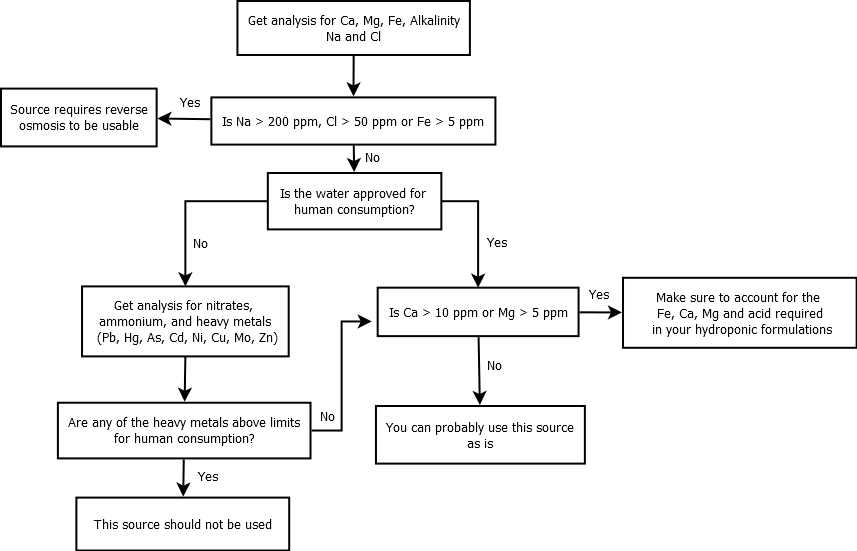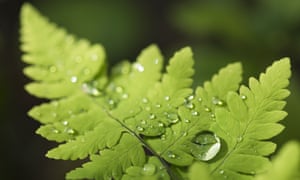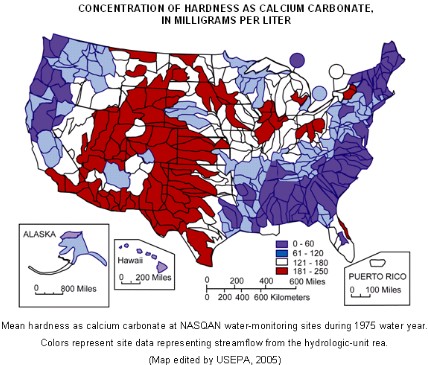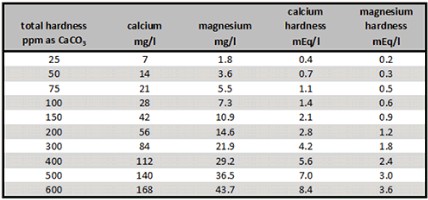Is my water source good for hydroponics?
Before starting your hydroponic project it is important to know whether your local water source can actually be used to water plants. Not all water sources are compatible with plants and some require special adaptations to the nutrient solution in order to become viable. In this post I will talk about the things that can make a water source unsuitable for hydroponics and the sort of modifications that would be required to make these water sources work with plants. The main points in the post are summarized in the diagram below.

Tap and well water sources can contain different substances characteristic of the natural environment where the water originated. Water that goes through rocky formations containing a lot of limestone will contain high amounts of calcium and carbonates, while water that goes through dolomitic rock will contain significant amounts of magnesium as well. Water that contains high amounts of Ca or Mg is not necessarily problematic and can be dealt with by adapting the nutrient solution to account for these ions, you can read more about hard water and its use in hydroponics by reading my previous post on the subject. These water sources usually need a significant amount of acid to reach the 5.5-6.5 range, so accounting for the nutrient contribution of the acid in the nutrient formulation is also fundamental.
The most problematic water sources will contain high amounts of either sodium or chlorides, two ions that we cannot deal with easily in hydroponics and that can be specially bad for plants. You can read more about sodium in hydroponics here, and chlorides and hydroponics here. Sodium concentrations below 200 ppm can be manageable, but any higher concentrations will invariably lead to issues in hydroponics. Chlorides are even more harmful with the threshold for problems at just 50 ppm. Iron can be similarly problematic as sources that contain high amounts of Fe can be incompatible with plants and the Fe can be difficult to remove. This is why the first step in analyzing a water source should always be an analysis including Na, Cl and Fe. If the values are too high then this water source will require reverse osmosis to be usable.
If Na, Cl and Fe are within limits then we can ask the question of whether this water source is approved for human consumption. If it is then we know that the amounts of heavy metals within it should be low, as well as the amount of other ions, such as nitrate and ammonium. If the water has not been approved by a utility company for human consumption then we need to do heavy metal and nitrate/ammonium analysis to figure out if this is actually safe to use. In some cases well water sources can be perfectly fine to grow plants but the products might be contaminated with heavy metals that make them unsuitable for human consumption.

If a water source is within limits for all of the above then we should take into consideration whether we need custom formulations or whether we can get away with using commercially available hydroponic products “as is”. For sources that have relatively low amounts of Fe, Ca and Mg this is usually a possibility but for sources that have quantities of Fe above 2.5 ppm, Ca above 10 ppm or Mg above 5 ppm, it is advisable to go with a custom formulation that can account for the amount of minerals already present within the water. This can still mean using commercially prepared fertilizers only that the mixing ratios and schedules need to be adapted to manage what is already present in the water, so significant deviations from the manufacturer suggestions are to be expected.
Another important point is that none of the above accounts for potential biological activity within the water, which can be a big source of problems in plant culture. For this reason always make sure to run the water through carbon filtration and have in-line UV filters to ensure that no bacteria, viruses or fungal spores get to your plants through your water source.

